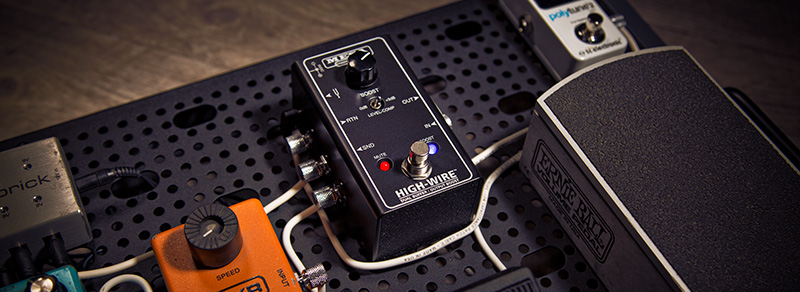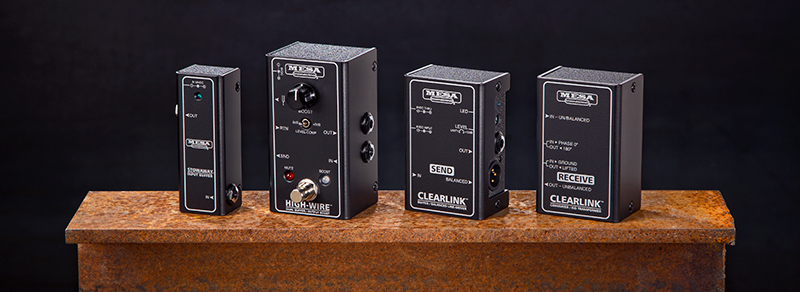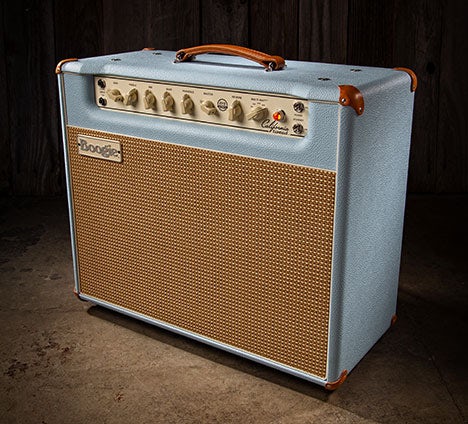Amplitudes: The Mesa Boogie Blog

History, Guitar Products, Bass Products
Meet MESA/Boogie® Signal Guru, Mario Marino
Today’s guitarists face the challenges that cabling, pedal designs, pedalboard layouts and rig concepts present - a loss of tone right where our signal chain starts. The focus of our new Signal Management line is to address these and other signal quality issues. When we started looking for areas where we could improve performance in the peripheral components connected to our amplifiers, or any amplifier for that matter, the key focus quickly became to deliver a level of quality and performance that was currently missing in other product designs. To achieve our goals, we partnered with a highly respected designer in the area of signal management, switching solutions and electronic component design – Mario Marino. Combining his expertise with our experience and production skill allows us to offer the highest quality signal management and switching solutions available.

Players and techs with experience in pro level rig setup have no doubt heard of Mario Marino through his work with top recording & touring artists as the owner/founder of Axess Electronics. Many former Axess customers have shared with us how excited they are to hear the news of Mario joining MESA®’s design team – all sharing the belief that if Mario is behind the design, it’ll be the best! For those of you who are not yet familiar with Mario’s work, we recently had the opportunity to sit down with Mario to discuss his background and his new role here at MESA®.
MB: Tell us how you found your way to music and the music industry?
Mario:
" I started playing guitar at age 13. My early influences were EVH, Randy Rhoads, Queen, and Rush. I quickly became obsessed with guitar pedals and ran into the tap dance and tone loss issues when plugging into my Boss pedals, and into my amp. Towards the end of high school, I was thinking of ways, beyond playing, that I could earn a living while still involving the guitar. After receiving an Electronics Engineering Technology diploma, I went to work for a data communications company, while making custom guitar audio and switching products for local guitarists. In 1998 I decided to make the business official. I launched a “homepage” on the web but needed a name… deciding on Axess Electronics (which was a play on words “axe" and “accessories”). The goal of Axess was simple - provide guitarists with high-quality guitar audio & switching products at a reasonable price and the best customer service possible. Not too long after, I was contacted by Dave Friedman at Rack Systems in North Hollywood. He said he could really use some of my products and that’s when it all really started. ”
MB: So, we know at that point things really took off for you. Tell us some highlights.
Mario:
" Yes - hard work and perseverance paid off. I became very busy, making custom products, some of which eventually turned into off-the-shelf products. I started building custom buffer/splitters for Alex Lifeson in support of Rush’s Vapor Trails tour, while my wife was literally having our first child. This was the start of providing Alex with many products over the years, and opportunities that provided incredible flashbacks to my teenage years! Next thing you know, Steve Stevens was using my RX1 Rack Router/Switcher, Eddie Van Halen had a BS2 Buffer/Splitter in his setup, I’m building custom buffer/splitters for Geddy Lee in support of the Snakes & Arrows tour and I’m providing gear to and/or working with; Brad Paisley, John Petrucci, Peter Frampton, Prince, Ian Thornley of Big Wreck, and Keith Scott of Bryan Adams. ”
MB: How did you connect with MESA/Boogie®?
Mario:
" By 2010, the pressure of trying to grow a business conservatively, while keeping up with every aspect of it from Product Design to Manufacturing, Shipping, Customer Support and Accounting just became too much. Plus, working seven days a week didn’t allow time for my family. So, I decided to stop taking orders, fulfilled existing orders, made sure customers were taken care of and closed up shop. When the folks at MESA got the news, I was approached about joining their design team. My relationship with the MESA brand goes way back, as my first brand new tube amp was a Mesa Mark III - purchased back in 1991. With the innovation and quality standards at MESA/Boogie being so similar to the goals I had set for my own company, it just seemed like a great fit. ”
MB: MESA® has now released a new line of your buffer designs. How do they stand out from other buffers?
Mario:
" When MESA’s VP, Jim Aschow, asked me of all the products I formally offered at Axess Electronics if I had a chance to re-do some of those designs, what would I do, my first response was buffers. Good buffers, the right buffers can be key to building a great guitar rig. I’ve often been asked, how much buffering is too much buffering? Some rigs require more than one buffer, there is just no getting around it. This lead to the question, should different buffer circuits/designs be used for different applications?
During my Axess days, the players, techs and rig builders I spoke with preferred using the term “musical” when describing buffers, instead of “transparent”, because the reality is, everything imparts some tonal quality all of its own. When starting to work on these new buffer designs, I went back and started from where I left off, the Axess BS2, and tried to see if I could improve it. I did - resulting in the CLEARLINK™ SEND Buffer/Line-Driver. The circuit still has its musical qualities, but with a little more give & take. It’s more organic or less hi-fi if you will. But because the question about different buffers, for different applications, was still lurking in my head, I re-educated myself on the beauty of discrete amplifier circuit designs. After prototyping and comparing several different discrete amplifier circuits, one really stood out - not only because of its musical tonal qualities but also because of its feel. These characteristics were the first thing that everyone usually noticed as soon as they plugged in and that buffer is what is now known as the STOWAWAY™ Input Buffer. This buffer is also found in the HIGH-WIRE™ Dual Buffer and Boost.
Revisiting my Axess BS2 buffer design would not be complete if I did not look into audio isolation transformers. Some guitarists try to avoid them because of a bad rep a few have garnered but not all audio isolation transformers are created equal. Working at MESA allowed me to explore the world of transformers. In doing so, I realized two things; first, there are only a handful of companies producing the highest quality audio isolation transformers, and second, a huge part of the sonic qualities of old recording consoles, that the majority of our holy grail of guitar tones were recorded with, included many, high-quality audio isolation transformers - which add warmth and tone, all of their own. My research in this area lead to the development of the CLEARLINK™ RECEIVE Converter / Iso Transformer. ”

Two and a half years and hundreds of hours of hard work after our initial meeting, we are proud to finally introduce the result of our collaboration to musicians in search of reclaiming their Tone. We know you’ll hear and feel the improvement these products have in the performance of your rig. Please visit the Signal Management line at www.mesaboogie.com or your local MESA Dealer to learn more about the STOWAWAY™ Input Buffer, HIGH-WIRE™ Dual Buffer/Output Boost, CLEARLINK™ SEND Output Buffer & Line Driver, and the CLEARLINK™ RECEIVE Converter/ISO Transformer. These solutions have been created with one goal in mind; ensuring your Tone is the very best it can be.



